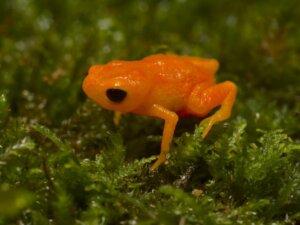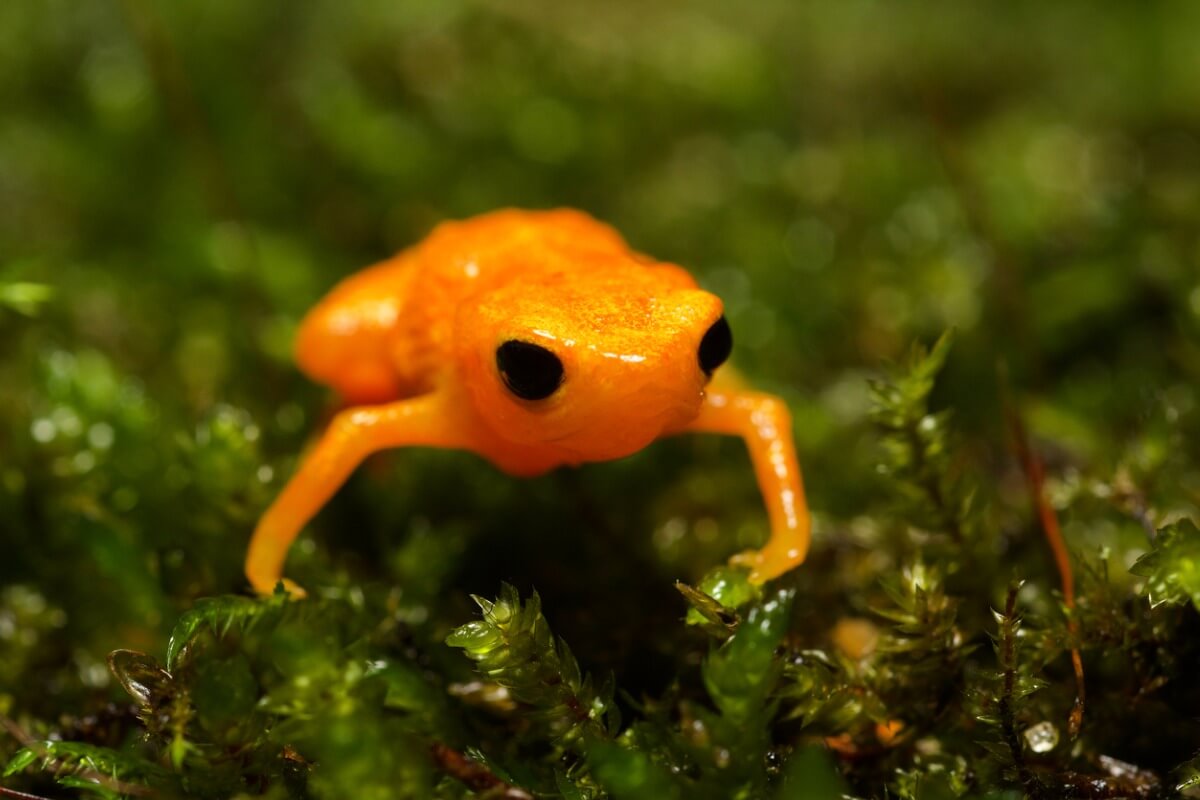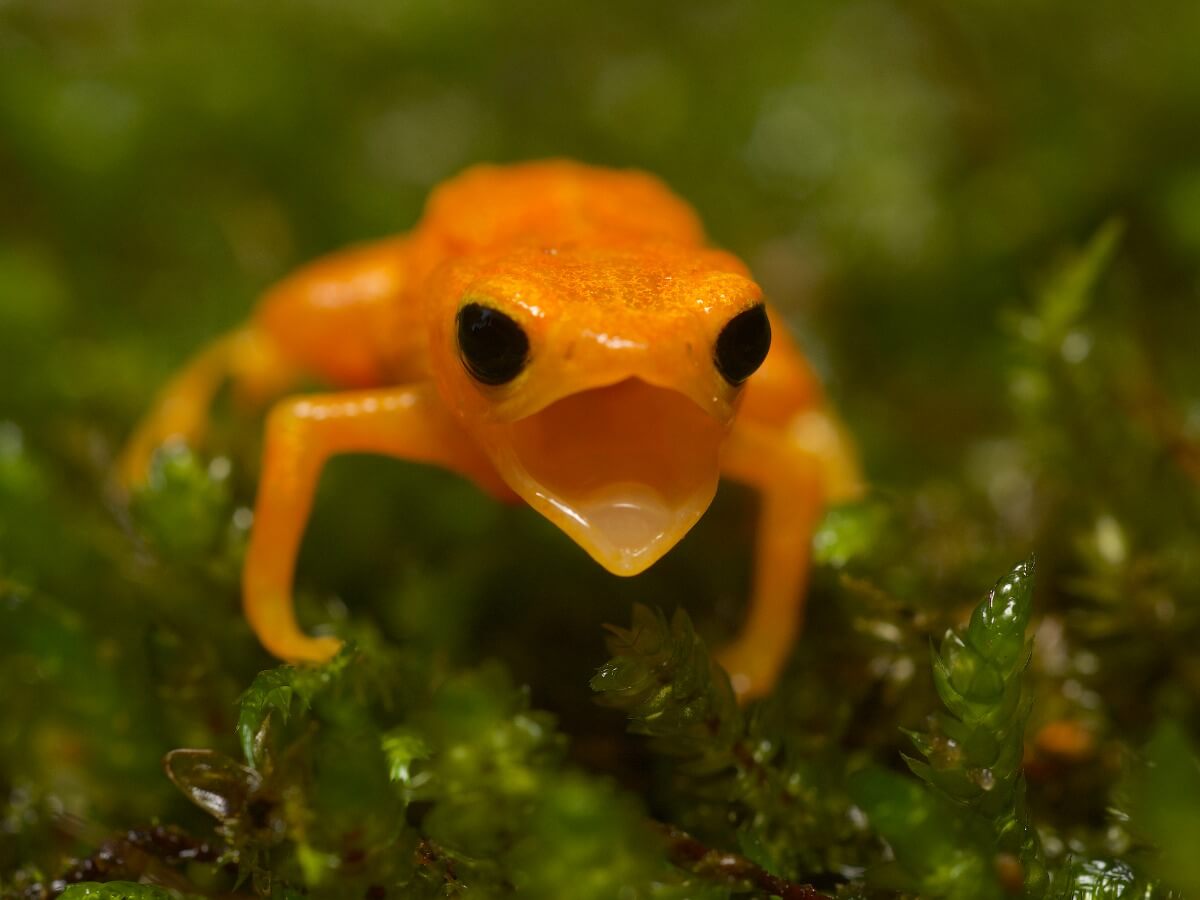The Pumpkin Toadlet: Habitat and Characteristics


Written and verified by the biologist Cesar Paul Gonzalez Gonzalez
Small, yellow and toxic. The pumpkin toadlet, also called Spix’s saddleback toad, is a bright-looking amphibian that inhabits the Atlantic forests. It stands out for its yellow color, almost identical to that of a pumpkin – hence the name in English!
As strange as it may seem, there isn’t only one type of pumpkin toadlet. In fact, 36 other species have been described, as indicated by studies in the scientific portal PLOS ONE. All are found under the same genus (Brachycephalus) and the differences focus on the biogeography of the species and its natural history.
Anyway, today we’re going to focus specifically on the Brachycephalus ephippium species. Read on to get to know this beautiful frog and its most striking features.
Habitat of the pumpkin toadlet
This peculiar amphibian lives among the bushes, plants, and trees, within the jungles of the Atlantic. Specifically, it lives in eastern Brazil, where its dominions extend up to almost 1,700 kilometers (about 1000 miles). Its population is usually restricted, but it’s able to occupy areas of up to 100 hectares. It can live at altitudes ranging from 200 to 1900 meters (650 – 6200 feet) above sea level.
This is a microendemic species, so it can only be found in mountainous and jungle environments. For this reason, populations are trapped on mountainous ‘islands’ that contain all the conditions for their survival, but which are surrounded by inhospitable valleys.
This is what has promoted the process of speciation, or what is the same, that more species of pumpkin toadlet appear from just one.

Physical characteristics
These tiny amphibians are about 2 centimeters (nearly an inch) long. Brachycephalus ephippium also presents hyperosification, which refers to dermal bone ornamentation. This phenomenon provides them with a dorsal shield, something similar to a ‘plate’ in the region of the back.
In general, this orange-yellow frog has opted for miniaturization. As a result, it has lost the phalanges on its hands and some of its toes aren’t functional. In the same way, because its head is wider than it is long, its eyes protrude a little.
Nor can we forget the Brachycephalus rotenbergae species, which has the peculiarity of glowing under ultraviolet light. This phenomenon seems to be related to their breeding season, although there’s still no conclusion about the usefulness of this mechanism.
Is the pumpkin toadlet poisonous?
The pumpkin toadlet follows the basic rule of color and poison. It has a vibrant yellow hue to warn predators that it’s toxic; in other words, it has an aposematic color. Its venom is called tetrodotoxin, which is a powerful neurotoxin capable of causing cardiac arrest in vertebrates.
Feeding and reproduction
This frog is a diurnal organism that consumes a wide variety of prey, mostly arthropods. It has a predilection for mites and springtails, although it also eats some spiders. Amphibian preferences seem to be related to their size and habitat.
In addition to this, it should be noted that the breeding season is similar to that of other amphibians. It prefers the rainy seasons to mate and the males actively maintain their territory, through vocalizations. In this way, they protect their foraging area, their resources and their eggs.
Frogs stay out in the rain so that their eggs don’t dry out, as this species practices external fertilization. Once the female accepts the male, she lays her eggs and the male fertilizes them with his sperm. This is why they need to perform the amplexus, a term that describes when the males hug the female, to ensure that the eggs are fertilized immediately when they hatch.
The female lays the eggs in about 30 minutes, which have a diameter of just 5.3 millimeters (0.2 inches) Once they’re fertilized, the mother covers her eggs with earth to hide and protect them. This also prevents the eggs from drying out, as they’ll take up to 64 days to hatch.
Conservation status of the pumpkin toadlet
Fortunately, this strange amphibian isn’t at risk of extinction. According to the Red List of the International Union for Conservation of Nature (IUCN), this is a species of least concern. However, this doesn’t mean that it is exempt from any danger, as information regarding this species is still minimal.
In fact, as morphological analysis progresses, new species of this type of frog are identified and reclassified.
One reason we must be careful with this species is its status as a microendemism. Being inhabitants of very specific regions in nature, the loss of their habitat can be catastrophic. This lack of niche could cause its extinction in a very short time interval.

Remember that striking colors may be alerting you to imminent danger; never underestimate them. Although this rule isn’t always fulfilled, it doesn’t hurt to take it into account. In the same way, don’t handle any species that you aren’t familiar with, and especially if it has such striking colors.
Small, yellow and toxic. The pumpkin toadlet, also called Spix’s saddleback toad, is a bright-looking amphibian that inhabits the Atlantic forests. It stands out for its yellow color, almost identical to that of a pumpkin – hence the name in English!
As strange as it may seem, there isn’t only one type of pumpkin toadlet. In fact, 36 other species have been described, as indicated by studies in the scientific portal PLOS ONE. All are found under the same genus (Brachycephalus) and the differences focus on the biogeography of the species and its natural history.
Anyway, today we’re going to focus specifically on the Brachycephalus ephippium species. Read on to get to know this beautiful frog and its most striking features.
Habitat of the pumpkin toadlet
This peculiar amphibian lives among the bushes, plants, and trees, within the jungles of the Atlantic. Specifically, it lives in eastern Brazil, where its dominions extend up to almost 1,700 kilometers (about 1000 miles). Its population is usually restricted, but it’s able to occupy areas of up to 100 hectares. It can live at altitudes ranging from 200 to 1900 meters (650 – 6200 feet) above sea level.
This is a microendemic species, so it can only be found in mountainous and jungle environments. For this reason, populations are trapped on mountainous ‘islands’ that contain all the conditions for their survival, but which are surrounded by inhospitable valleys.
This is what has promoted the process of speciation, or what is the same, that more species of pumpkin toadlet appear from just one.

Physical characteristics
These tiny amphibians are about 2 centimeters (nearly an inch) long. Brachycephalus ephippium also presents hyperosification, which refers to dermal bone ornamentation. This phenomenon provides them with a dorsal shield, something similar to a ‘plate’ in the region of the back.
In general, this orange-yellow frog has opted for miniaturization. As a result, it has lost the phalanges on its hands and some of its toes aren’t functional. In the same way, because its head is wider than it is long, its eyes protrude a little.
Nor can we forget the Brachycephalus rotenbergae species, which has the peculiarity of glowing under ultraviolet light. This phenomenon seems to be related to their breeding season, although there’s still no conclusion about the usefulness of this mechanism.
Is the pumpkin toadlet poisonous?
The pumpkin toadlet follows the basic rule of color and poison. It has a vibrant yellow hue to warn predators that it’s toxic; in other words, it has an aposematic color. Its venom is called tetrodotoxin, which is a powerful neurotoxin capable of causing cardiac arrest in vertebrates.
Feeding and reproduction
This frog is a diurnal organism that consumes a wide variety of prey, mostly arthropods. It has a predilection for mites and springtails, although it also eats some spiders. Amphibian preferences seem to be related to their size and habitat.
In addition to this, it should be noted that the breeding season is similar to that of other amphibians. It prefers the rainy seasons to mate and the males actively maintain their territory, through vocalizations. In this way, they protect their foraging area, their resources and their eggs.
Frogs stay out in the rain so that their eggs don’t dry out, as this species practices external fertilization. Once the female accepts the male, she lays her eggs and the male fertilizes them with his sperm. This is why they need to perform the amplexus, a term that describes when the males hug the female, to ensure that the eggs are fertilized immediately when they hatch.
The female lays the eggs in about 30 minutes, which have a diameter of just 5.3 millimeters (0.2 inches) Once they’re fertilized, the mother covers her eggs with earth to hide and protect them. This also prevents the eggs from drying out, as they’ll take up to 64 days to hatch.
Conservation status of the pumpkin toadlet
Fortunately, this strange amphibian isn’t at risk of extinction. According to the Red List of the International Union for Conservation of Nature (IUCN), this is a species of least concern. However, this doesn’t mean that it is exempt from any danger, as information regarding this species is still minimal.
In fact, as morphological analysis progresses, new species of this type of frog are identified and reclassified.
One reason we must be careful with this species is its status as a microendemism. Being inhabitants of very specific regions in nature, the loss of their habitat can be catastrophic. This lack of niche could cause its extinction in a very short time interval.

Remember that striking colors may be alerting you to imminent danger; never underestimate them. Although this rule isn’t always fulfilled, it doesn’t hurt to take it into account. In the same way, don’t handle any species that you aren’t familiar with, and especially if it has such striking colors.
All cited sources were thoroughly reviewed by our team to ensure their quality, reliability, currency, and validity. The bibliography of this article was considered reliable and of academic or scientific accuracy.
- Nunes, I., Guimarães, C. S., Moura, P. H. A., Pedrozo, M., de Toledo Moroti, M., Castro, L. M., … & Muscat, E. (2021). Hidden by the name: A new fluorescent pumpkin toadlet from the Brachycephalus ephippium group (Anura: Brachycephalidae). Plos one, 16(4), e0244812.
- Clemente-Carvalho, R. B. G., Alves, A. C. R., Perez, S. I., Haddad, C. F. B., & Dos Reis, S. F. (2011). Morphological and molecular variation in the Pumpkin Toadlet, Brachycephalus ephippium (Anura: Brachycephalidae). Journal of Herpetology, 45(1), 94-99.
- Clemente-Carvalho, R. B. G., Monteiro, L. R., Bonato, V., Rocha, H. S., Pereira, G. R., Oliveira, D. F., … & Dos Reis, S. F. (2008). Geographic variation in cranial shape in the pumpkin toadlet (Brachycephalus ephippium): a geometric analysis. Journal of Herpetology, 42(1), 176-185.
- Sebben, A., Schwartz, C. A., Valente, D., & Mendes, E. G. (1986). A tetrodotoxin-like substance found in the Brazilian frog Brachycephalus ephippium. Toxicon, 24(8), 799-806.
- Pombal Jr, J. P., Sazima, I., & Haddad, C. F. (1994). Breeding behavior of the pumpkin toadlet, Brachycephalus ephippium (Brachycephalidae). Journal of Herpetology, 516-519.
- Almeida-Santos, M., Siqueira, C. C., Van Sluys, M., & Rocha, C. F. D. (2011). Ecology of the Brazilian flea frog Brachycephalus didactylus (Terrarana: Brachycephalidae). Journal of Herpetology, 45(2), 251-255.
- Pie, M. R., Meyer, A. L., Firkowski, C. R., Ribeiro, L. F., & Bornschein, M. R. (2013). Understanding the mechanisms underlying the distribution of microendemic montane frogs (Brachycephalus spp., Terrarana: Brachycephalidae) in the Brazilian Atlantic Rainforest. Ecological Modelling, 250, 165-176.
This text is provided for informational purposes only and does not replace consultation with a professional. If in doubt, consult your specialist.








